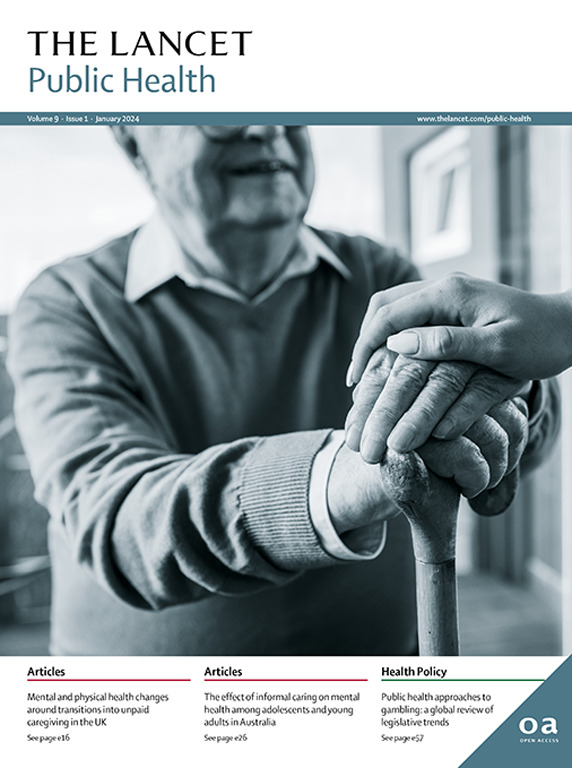1990-2021年东南亚国家联盟(东盟)国家的吸烟流行病学和负担:《2021年全球疾病负担研究》的调查结果
IF 25.4
1区 医学
Q1 PUBLIC, ENVIRONMENTAL & OCCUPATIONAL HEALTH
引用次数: 0
摘要
长期以来,吸烟一直是东南亚国家联盟(东盟)的区域卫生优先事项。尽管几十年来一直致力于实施烟草控制措施,但东盟区域在扭转这一流行病方面继续面临重大挑战。我们的目的是分析有关吸烟率和可归因疾病负担的纵向数据,以了解吸烟流行的轨迹,为确定优先事项提供信息,并使有效的政策规划成为可能。方法:我们使用来自2021年全球疾病、伤害和风险因素负担研究(GBD)的数据,按年龄和性别评估1990年至2021年10个东盟成员国的吸烟患病率及其归因疾病负担。使用时空高斯过程回归模型对当前吸烟率进行了估计,该模型综合了来自东盟地区159个不同数据源的数据以及来自其他GBD国家的2646个数据源的数据。36种健康结果的剂量反应风险采用最新的举证责任方法得出。随后计算并应用人口归因分数,以确定这些国家因吸烟导致的死亡率、生命损失年数、残疾生活年数和残疾调整生命年(DALYs)方面的负担。2021年,东盟地区约有1.37亿(95%不确定区间为134-139)名15岁及以上的吸烟者,男性年龄标准化患病率估计为48.4%(47.5 - 49.2),女性为4.47%(4.09 - 4.92)。吸烟占该地区全因死亡率的10.8%(8.86 - 12.9%)。吸烟导致的死亡和伤残年总数分别为52.6万例(43.3万- 622万)和1570万例(12.9 - 18.5)伤残年。整个区域的死亡率差别很大,尤其是男性死亡率,从新加坡的每10万男性68.9人(55.8 - 84.2人)到柬埔寨的每10万男性364人(279-463人)不等。尽管1990年至2021年期间,大多数东盟国家的吸烟率大幅下降,但吸烟者的绝对人数增加了63.3%(59.0 - 67.8),10岁及以上的吸烟者人数增加了55.3亿(50.2 - 56.2)。在东盟地区,吸烟仍然是一个持续存在的公共卫生威胁。整个区域存在着相当大的差异:一些国家在烟草控制方面取得了显著进展,而另一些国家则落后。吸烟作为一种受商业决定因素严重影响的可改变的风险因素,可以通过有效的政策变化加以控制。作为一个地缘政治和经济合作网络,东盟国家必须共同努力,克服阻碍反烟草努力的障碍,并集体制定战略,加强整个区域的烟草控制。资助布隆伯格慈善基金会和比尔基金会梅琳达·盖茨基金会。本文章由计算机程序翻译,如有差异,请以英文原文为准。
The epidemiology and burden of smoking in countries of the Association of Southeast Asian Nations (ASEAN), 1990–2021: findings from the Global Burden of Disease Study 2021
Background
Tobacco smoking has long been a regional health priority for the Association of Southeast Asian Nations (ASEAN). Despite decades of commitment to implementing tobacco control measures, the ASEAN region continues to face substantial challenges in reversing the epidemic. We aimed to analyse longitudinal data on smoking prevalence and attributable disease burden to understand the trajectory of the smoking epidemic, inform priority setting, and enable effective policy planning.Methods
We used data from the Global Burden of Diseases, Injuries, and Risk Factors Study (GBD) 2021 to evaluate the prevalence of tobacco smoking and its attributable disease burden in the ten ASEAN member states by age and sex, from 1990 to 2021. Current smoking prevalence was estimated using spatiotemporal Gaussian process regression models, which synthesised data from 159 distinctive data sources specific to the ASEAN region in addition to 2646 data sources from other GBD countries. Dose–response risks for 36 health outcomes were derived using the latest burden of proof approach. Population attributable fractions were subsequently calculated and applied to determine the burden in terms of mortality, years of life lost, years lived with disability, and disability-adjusted life-years (DALYs) attributable to tobacco smoking in these countries.Findings
In 2021, there were approximately 137 million (95% uncertainty interval 134–139) current smokers aged 15 years and older in the ASEAN region, with an estimated age-standardised prevalence of 48·4% (47·5–49·2) among males and 4·47% (4·09–4·92) among females. Tobacco smoking accounted for 10·8% (8·86–12·9) of all-cause mortality across the region. The total number of deaths and DALYs attributed to smoking were 526 000 deaths (433 000–622 000) and 15·7 million (12·9–18·5) DALYs. Death rates varied considerably across the region, especially among males, ranging from 68·9 (55·8–84·2) per 100 000 males in Singapore to 364 (279–463) per 100 000 males in Cambodia. Although smoking prevalence declined substantially in most ASEAN countries between 1990 and 2021, the absolute number of smokers increased by 63·3% (59·0–67·8), and the number of smokers aged 10 years and older increased by 53·0 million (50·2–56·2).Interpretation
Tobacco smoking remains a persistent public health threat in the ASEAN region. Considerable disparities exist across the region: while some countries have made remarkable progress in tobacco control, others lag behind. As a modifiable risk factor heavily influenced by commercial determinants, smoking can be controlled through effective policy changes. As a geopolitical and economic collaboration network, ASEAN countries must work together to overcome barriers hindering anti-tobacco efforts and collectively devise strategies to strengthen tobacco control across the region.Funding
Bloomberg Philanthropies and the Bill & Melinda Gates Foundation.求助全文
通过发布文献求助,成功后即可免费获取论文全文。
去求助
来源期刊

Lancet Public Health
Medicine-Public Health, Environmental and Occupational Health
CiteScore
55.60
自引率
0.80%
发文量
305
审稿时长
8 weeks
期刊介绍:
The Lancet Public Health is committed to tackling the most pressing issues across all aspects of public health. We have a strong commitment to using science to improve health equity and social justice. In line with the values and vision of The Lancet, we take a broad and inclusive approach to public health and are interested in interdisciplinary research.
We publish a range of content types that can advance public health policies and outcomes. These include Articles, Review, Comment, and Correspondence. Learn more about the types of papers we publish.
 求助内容:
求助内容: 应助结果提醒方式:
应助结果提醒方式:


